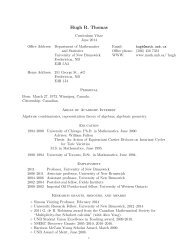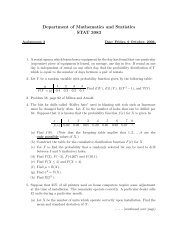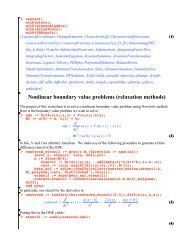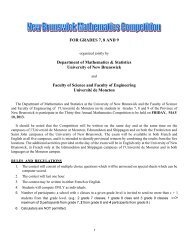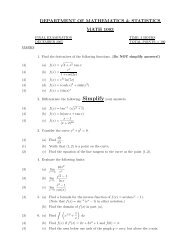Exam II, 2013 - UNB Department of Mathematics and Statistics
Exam II, 2013 - UNB Department of Mathematics and Statistics
Exam II, 2013 - UNB Department of Mathematics and Statistics
You also want an ePaper? Increase the reach of your titles
YUMPU automatically turns print PDFs into web optimized ePapers that Google loves.
<strong>Department</strong> <strong>of</strong> <strong>Mathematics</strong> <strong>and</strong> <strong>Statistics</strong><br />
University <strong>of</strong> New Brunswick<br />
Math 3003 <strong>Exam</strong>ination #2 Winter, <strong>2013</strong><br />
Instructions: Complete any 3 <strong>of</strong> the following 5 problems. Each problem is<br />
worth 20 marks, the marks for each subproblem are shown in the left margin.<br />
1. Consider the inner product space consisting <strong>of</strong> the set <strong>of</strong> continuous function<br />
on the interval [−1, 1] with the inner product given by<br />
〈f, g〉 =<br />
∫ 1<br />
−1<br />
x 2 f(x)g(x) dx<br />
[6]<br />
[6]<br />
[8]<br />
(a) Show that the polynomials 1 <strong>and</strong> x are orthogonal with respect to<br />
this inner product.<br />
(b) Find a quadratic (degree 2) polynomial orthogonal to the span <strong>of</strong><br />
{1, x}.<br />
(c) Let f be the function defined by f(x) = x 2/3 , −1 ≤ x ≤ 1. Find the<br />
projection <strong>of</strong> f onto the span <strong>of</strong> {1, x}.<br />
2. Consider the sequence <strong>of</strong> functions (f n ) defined by f n (x) = nxe −nx , 0 ≤<br />
x ≤ 1.<br />
[6]<br />
[7]<br />
(a) Compute lim f n(x).<br />
n→∞<br />
(b) Does the sequence (f n ) converge uniformly<br />
(c) Does the sequence converge with respect to the norm ‖f‖ = ∫ 1<br />
0 |f(x)|dx<br />
[7]<br />
1
3. Let f n be the function defined by<br />
⎧<br />
1, −1 ≤ x ≤ 0,<br />
⎪⎨<br />
1 + nx, 0 < x < 1/n,<br />
f n (x) =<br />
3 − nx, 1/n ≤ x ≤ 4/n,<br />
⎪⎩<br />
−1, 4/n < x ≤ 4,<br />
for positive integers n.<br />
[3]<br />
[3]<br />
[3]<br />
[4]<br />
[3]<br />
[4]<br />
(a) What is the domain <strong>of</strong> f n <br />
(b) For what values <strong>of</strong> x is f n continuous<br />
(c) For what values <strong>of</strong> x is f n differentiable<br />
(d) What are sup f n <strong>and</strong> inf f n .<br />
(e) What are lim inf f n (x) <strong>and</strong> lim sup f n (x).<br />
(f) Does (f n ) converge If so, to what limit <strong>and</strong> in what sense<br />
[4]<br />
[6]<br />
[4]<br />
[6]<br />
4. (a) Provide a resonable definition <strong>of</strong> lim a n = ∞.<br />
(b) Suppose that (x n ) is monotone increasing <strong>and</strong> divergent. Prove that<br />
lim x n = ∞.<br />
(c) Suppose a <strong>and</strong> b are positive real numbers <strong>and</strong> consider the sequence<br />
generated by the iteration x n+1 = (b+1/x n ) −1 for n > 0 with x 1 = a.<br />
i. Show that x n is decreasing.<br />
ii. Prove that lim x n exists <strong>and</strong> find it.<br />
5. Recall that a function f is continuous at the point a if given any real<br />
number ɛ > 0, there is a real number δ so that the following is true:<br />
|f(x) − f(a)| < ɛ, whenever |x − a| < δ.<br />
[14]<br />
[6]<br />
(a) Using this definition, prove that the function f defined by f(x) =<br />
2x + 1 is continuous at x = 1.<br />
(b) Using this definition, prove that the function g defined by g(x) = 1/x,<br />
for 0 < x < 1, is continuous at every point in the interval (0, 1).<br />
2


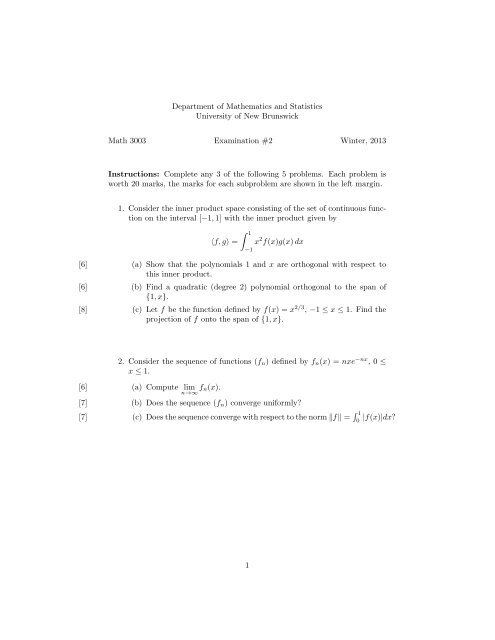
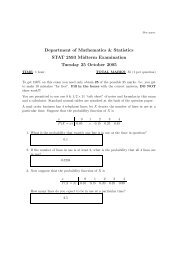
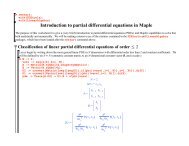
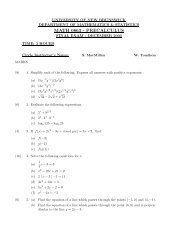

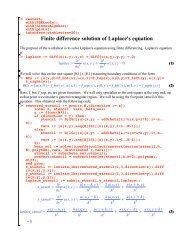
![1]] CHAPTER 2 LIMITS AND DERIVATIVES](https://img.yumpu.com/40053548/1/190x245/1-chapter-2-limits-and-derivatives.jpg?quality=85)

